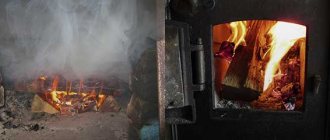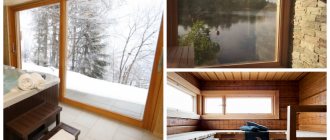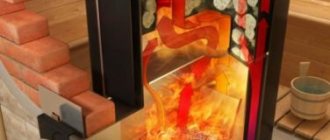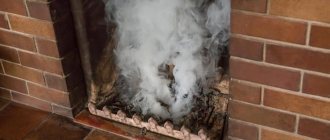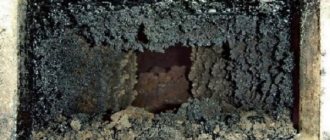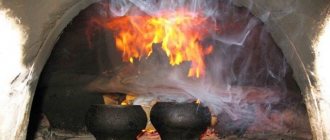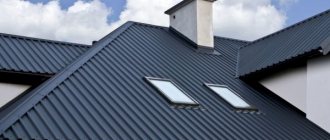Bath lovers quite often encounter the phenomenon of poor draft in the stove. There can be many reasons for this phenomenon, since many of them are laid down at the design and construction stage, while others arise due to a number of other factors.
If you intend to build a sauna stove yourself, then you definitely need to know some points on which the further operation of the sauna stove will depend. Before you can solve a problem, you should make sure that it exists. There are signs that indicate that cravings are impaired:
- the wood smokes heavily;
- weak traction;
- smoke enters the room when the firebox door opens;
- The glass on the door smokes a lot.
If these signs are present, then it is worth understanding the reasons for the appearance of chimney draft.
Soot layering
When fuel burns, soot is formed. Over the years, it accumulates, which leads to a narrowing of the pipe diameter. Already a pipe - worse traction. Therefore, you need to clean the chimney regularly. This simple procedure not only increases draft, but also increases the effect of the stove.
Special briquettes are provided to clean the chimney from soot.
They eat away soot, soot, creosote and tar. They contain virtually no moisture or non-combustible impurities. Combustion products leave the pipe with a stream of hot air.
conclusions
So, how to increase draft in a chimney? Here are a few simple steps that don't require much time or money:
- Clean the chimney of soot. This is the first thing to do. You can do this yourself, with minimal investment of time, effort and money.
- Provide air flow. Open the window for 5-10 minutes before lighting the fire. This will create the correct movement of air in the room from bottom to top. The window can be closed after the fire has burned out.
- Insulate the chimney if it is not insulated. This will reduce the influence of cold air and also extend the life of the chimney.
As a rule, these simple actions are enough to increase chimney draft . If the problem is related to the design features of the chimney duct, then more serious resources will be required to solve it.
Often, steam lovers are faced with a pressing question: where did the draft in the sauna stove go? There are several reasons for the problem, some are due to errors in design or production. It is important for a home craftsman to know about the main ones and the simplest ways to detect and remove smoke in a steam room.
Air pressure
The condition of the chimney is also affected by the climate outside the bathhouse. If the temperature outside drops, there is a decrease in traction. Cold air sinks down and exerts pressure. Often, a clogged pipe and cold air work together to create a “clog.”
This problem can be solved in two steps: 1) cleaning the chimney with a briquette; 2) its insulation. Basalt wool, ceramic fiber-based material and fire-resistant boards are suitable as insulation. Ready-made cylindrical insulation materials are also available for sale.
Stabilizing devices
The reason for the lack of draft in a chimney located in a bathhouse in a residential building may be overheating of the outlet pipe, leading to a temperature difference and sedimentation of combustion products on the inner walls of the pipe in the form of condensate.
The stabilizing device consists of a regulator equipped with a temperature sensor and a fuse damper. When the temperature rises, the sensor gives a command to open the damper, and cold air flows through the hole, equalizing temperatures and pressures.
Metal visor
As planned, the canopy should be useful - it protects the pipe from precipitation. But often this protective barrier brings only problems. In a confined space, smoke escape is difficult. Traction worsens due to an artificial air plug.
There are two ways to deal with this problem:
1) complete refusal of the visor;
2) moving the visor higher from the pipe.
An alternative to the classic visor is nozzles with exhaust deflectors or weather vanes-deflectors.
Chimney cleaning
Chimney cleaning
The traction was good up to a certain point, but over time something happened? Most likely, the channels are simply clogged. When various materials burn, soot is released. If the surface of the pipe is not smooth enough or there are many turns, then the soot will definitely settle. Accumulating over time, dross will narrow the passage, which will certainly impair passability.
Plaque has formed on the walls of the chimney
Periodically, the channels need to be cleaned; this can be done mechanically and chemically.
Traditional methods include:
- Peeling with potato skins or the potatoes themselves. In order to implement this method, you need to throw chopped potatoes or potato peelings into a well-heated oven. Usually it takes about one bucket. During the combustion process, steam is released that contains starch - it is this that softens the soot. Some of the carbon deposits fall off on its own; the remaining layer may have to be removed by mechanical means.
- Aspen firewood. They have high heat capacity. You need a few good logs. But before using this method, be sure to check the condition of the sunbed and riser. If you are not sure of their reliability, do not try to clear soot from the chimney using this method. During the process, the channels become very hot, which can lead to a fire.
- Rock salt. It is added as the wood burns. But you shouldn’t expect any special effect, because this option is more intended for prevention.
Kominichek
The most popular chemicals are Kominichek and Log Chimney Sweep. These products are placed on the coals and left for a certain time, according to the instructions. During the combustion process, compounds are released that destroy soot deposits. Manufacturers recommend that after they burn out, do not remove the coals until the next kindling, because some substances continue to act.
Chemical cleaning methods have their detractors, who say that their use can lead to the destruction of the chimney. Actually this is not true. The principle of operation is not that the reagent flares up to ultra-high temperatures, but that a chemical reaction occurs with the soot due to compounds that are released into the air. This, on the contrary, helps to avoid problems, because if soot catches fire, then a fire cannot be avoided (its combustion temperature can reach 1200˚C, only a ceramic pipe can withstand such a load).
Mechanical chimney cleaning
You can clean it mechanically.
- To do this you will need a brush. If it is not possible to purchase a special one, then you can make it yourself. To do this, you need to take two planks that will follow the shape of the chimney. Their size should be 1 cm smaller on each side. Between them it is necessary to place plates made from a plastic bottle. They should protrude by this missing centimeter. They need to be cut to form cloves.
- Cleaning should be carried out only in good weather to avoid falling from a height.
- Close all doors on the stove and fireplace. If this is not possible, then curtain them with a thick, damp cloth. It is also better to cover all the furniture in the room with oilcloth, this will protect it, because soot can damage the fabric irrevocably.
- A holder should be attached to the brush, the length of which will depend on the length of the pipe.
- You need to climb onto the roof and secure yourself using safety ropes.
- The soot is knocked downwards using forward movements. Next, it will need to be removed through special holes that are provided in the chimney channels.
It is better not to clean metal pipes this way. Using a brush can damage the walls, which will cause soot to linger and accumulate even more. If during the process you notice a serious blockage, then you will have to break through it using a special metal ball, which is suspended on a cable or chain.
Depressurization
Depressurization occurs both in old baths and in new ones - if serious mistakes were made during the installation of the pipe. The chimney loses its tightness due to cracks, shifts and other damage.
To seal the pipe, high-temperature sealants or so-called are used. polymer stockings.
The tightness of the chimney is a guarantee of safety. If this condition is not met, the risk of fire increases significantly, since sparks or ash can get into the holes.
Source
Pipe cleaning
Work should begin with cleaning the chimney. All doors in the stove and smoke ducts must be tightly closed and secured. If a large amount of soot falls from a height of 3-4 m, dust may be released into the house. A special brush is used for cleaning; if you don’t have a ready-made one, you can do it yourself.
The device will require a strong rope or cable. At one end you should attach a weight weighing 2-3 kg and a pair of old hard washcloths. You can use a fluffy ball of wire, stiff cord, or something similar. The fastening must be strong; parts that come off and get stuck in the pipe can cause a lot of problems.
You need to climb onto the roof with the brush, lower it into the pipe, pull it up and down several times, if possible, rotating and swinging it to the sides. Similar work needs to be done to understand why the fireplace is smoking. If after cleaning the operation stabilizes, the problem is solved. Otherwise, you need to look further.
If the stove is used for seasonal heating and cooking, the chimney should be cleaned once a quarter. This should be done more often if resinous or damp firewood is used. This causes excessive deposits and narrowing of the lumen. Mechanical cleaning can be done independently using traditional techniques that have not changed over the past centuries. Work is carried out wearing protective glasses and gloves. For activities at heights, you need non-slip shoes and insurance.
From the roof side
You will need a cable on which hard brushes are attached to clean the chimney from soot, and a heavy round weight with an eye. A brush can be made from an old plastic bottle.
Cleaning is carried out in five stages:
- To prevent soot from entering, cover the firebox and hatches with a wet rag.
- Remove the head and inspect the canal.
- Clean with a broom to remove cobwebs and debris.
- Use a weight to break through the blockage several times.
- Clean the chimney walls with brushes.
Finally, you will need to clean up the soot from the roof and inside the firebox.
From the oven side
Cleaning the chimney from the stove side
You need a special brush with a rigid but flexible fiberglass cable. It can be purchased at a hardware store.
Cleansing also takes place in five steps:
- Unscrew the hatch plug for cleaning,
- Clear the entrance of debris.
- Attach a suitable brush (for metal pipes only a plastic one).
- Clean the canal, slowly moving the instrument upward.
- The firebox is cleaned in the same way.
You can use traditional methods. Periodically complete the kindling with a few alder or aspen logs. This prevents the formation of soot. But you should not add any powders to the firewood, since some of these methods can lead to an explosion.
To prevent the stove from smoking, check the draft periodically. Do not use coniferous or wet firewood or garbage. From time to time, carry out preventive inspections of the chimney, because most often the stove smoke occurs due to its clogging. However, other problems can also lead to this. If you correctly determine the cause, you can quickly correct the situation yourself or with the help of a specialist.
No draft in the chimney? Found a simple solution to the problem
Recently I began to notice a burning smell and smoke in my home. After “consulting” with the Internet, I realized that the root of the problem was poor traction. Before moving on to repairing the chimney, I needed to determine the reason why the draft disappeared.
Often the secret lies in an incorrectly assembled chimney (for example, a leaky pipe connection). But it’s not always a matter of crooked hands and shortcomings made during construction. Other prerequisites include:
The first thing I decided to do was clean the pipe. It’s worth admitting right away that I didn’t pay enough attention to the condition of the exhaust pipe and its “fouling” with layers of soot seemed quite logical to me. To clean the chimney, I used a proven method - mechanical. As a “helper” I took with me a brush on a long rope. I carried out the cleaning on the roof, which caused surprised looks from the neighbors.
My acrobatic attempts did not lead to any tangible results, and I continued to “dig” further. Next in line was checking the gate. The gate is responsible for several functions:
If the damper is installed correctly, it does not dangle, does not get stuck and opens freely. There was nothing to do, I climbed onto the roof again. To my regret, a thorough check of the gate did not yield any results - it stands firmly, does not wobble, opens and closes without any extra effort.
In desperation, I finally decided to use a prompt called “Call a Friend.”
I don't like using friends for practical purposes, but I had no choice. Nikita, a builder with twenty years of experience, kindly agreed to inspect the chimney. Imagine my surprise when the problem turned out to be trees. The house is indeed surrounded by tall trees, but it would never have occurred to me that this factor would matter.
It turns out that due to regular gusts of wind, turbulence occurs over the roof, which prevents normal air circulation. To increase traction, Nikita advised me to buy a deflector.
No sooner said than done. Externally, it looks like a turbine, which is installed on the top of the chimney.
Due to the force of the wind, the deflector pumps smoke from the pipeline shaft. This design serves three main purposes: it protects the pipeline from debris and weather conditions, increases draft, and suppresses flying sparks.
The deflector promotes forced discharge when the air flow passes through its narrowing channel. First, the gases end up in a rarefied space in the neck of the chimney, after which they leave the pipe due to increased draft.
After installing the deflector, the obsessive smell of burning left all the rooms - hopefully forever.
Source
The principle of furnace draft
With the correct structure of the stove and clean channels, draft should form naturally, since the necessary conditions for its occurrence are inherent in the design of the heating structure itself.
This diagram shows a combined design that includes not only a Russian stove with a stove bench, but also a separate kitchen stove with its own firebox. In addition, for the second floor, a fireplace is “embedded” into the common chimney.
The main thing in this process is the chimney, through which smoke is removed from the functioning stove. When the fuel mass burns, an area of rarefied air is formed due to the difference in the height of the combustion chamber, smoke exhaust channels and the mouth (outlet) of the chimney pipe. Thus, a traction force arises, facilitating the removal of gaseous combustion products.
Another significant factor is the temperature difference in the combustion chamber and in the atmosphere, since heated air tends upward to lower temperatures.
It would seem that the principle of draft formation is simple, however, there are enough points that can complicate the process of removing combustion products.
Often there is no traction due to external factors. But it may also depend on incorrectly calculated parameters of some parts of the furnace structure. In any case, if such a problem arises, first of all it is necessary to find its cause, and then look for ways to eliminate it.
Why does the stove smoke in the bathhouse?
The construction of a sauna stove is relatively simple. The design includes 4 functional elements:
If there is no draft in the bathhouse, the cause is any violation in the operation or structure of the structural elements, with the exception of the heater.
Errors in the design of the furnace leading to smoke
If, at the first attempt to light the stove in the bathhouse, smoke comes out, this indicates design errors. It is recommended to immediately contact a specialist:
Important!
If smoke does not appear in the bathhouse immediately, but after several years of operation, this does not indicate a design error, but a malfunction or exhaustion of the resource.
Pipe length
The height of the chimney in the bathhouse matters. It must rise above the ridge of the building, otherwise the draft will not be enough for normal operation of the furnace. The smoke exhaust structure is protected with a metal cap. If it is not there, strong winds can easily penetrate inside and prevent smoke from being removed.
Another design error is the location of the smoke exhaust duct at the same level as the combustion chamber door or even below it. In this case, normal draft is not enough to prevent the smoke from returning.
The best option is a straight pipe. Deviation from the vertical is allowed, but weakens traction. Turns and angles increase the risk of clogging.
Insufficient chimney cross-section
The dimensions of the stove in the bathhouse depend on the size of the heated room. This parameter determines not only the dimensions of the combustion chamber, but also, accordingly, the diameter of the chimney. These device parameters are of decisive importance:
Important!
The best option for a stove in a bathhouse is a steel chimney. However, this option must be thermally insulated, and not only when passing through the ceiling, but along the entire length.
Leaky chimney
Cracks in the brickwork or burning through the seams of a metal chimney makes it leaky. This is a very dangerous problem, since through such openings smoke enters the room, and in an inconspicuous amount. The user does not feel the appearance of carbon monoxide, and the latter at a minimum concentration can lead to death.
Also, sparks get inside the steam room through the joints, and this threatens a fire in the bathhouse.
Against the background of such dangers, traction failure does not seem to be a serious problem. However, it is also present. Repair of sauna stoves includes inspection of joints and seams for tightness and elimination of violations.
If you found this article useful, please like and subscribe to our channel. Don't forget to share information with your friends on social networks.
Source
Main problems
Pipe length
This value has a major influence on the correct operation of the exhaust gas extractor. It is important to know and follow the rules for its manufacture and installation.
The minimum distance between the end of the chimney and the ridge of the roof when it exits near the top edge is 500-700 mm. The optimal size is 1000 mm.
If the chimney exits lower down the slope, in this case, the upper edge of the pipe should be located taking into account the basic rule.
This arrangement does not allow vortex flows at the upper edge to create difficulties for the exit of exhaust gases. In strong winds, turbulence in the flow will cause reverse draft, and smoke will escape into the room. To troubleshoot problems, you will need to correctly install the pipe to the required height.
When building a bathhouse, pay attention to this factor so that later you do not have to dismantle the roof structure and do the work again.
Insufficient chimney cross-section
This reason affects the amount of gas passage. It is recommended to lay brick or use a steel pipe with a minimum size of 120-130 mm. By reducing the diameter of the outlet channel, especially when using damp firewood, you risk getting a permanently smoky bathhouse, in any weather, even calm weather.
During the construction and installation of the stove, be sure to pay attention to the size of the exhaust duct. Otherwise, you will have to completely disassemble and redo the chimney, installing a pipe of sufficient diameter. Follow the rules when installing a chimney.
The blower is not long enough
Poor draft in a sauna stove can occur if the dimensions of the blower or ash drawer are not taken into account during manufacturing. This value is especially important when lighting the stove after a long break. The problem will be solved by equipping a sufficient chamber for collecting ash and equipping the furnace with a gate valve.
It is recommended that you initially take the advice of experienced stove makers if you have insufficient experience in making sauna stoves with your own hands or make a stove according to a finished drawing, strictly observing all dimensions.
To eliminate such a malfunction of the stove, you will need to completely disassemble it if it is lined with bricks or add a sufficient ash compartment in the lower part of the stove.
Leaky chimney
Such a breakdown allows smoke to escape into the room. Smoke looks for an outlet in the most accessible place, so it will definitely find a leaky hole in a pipe or on a seam. In this case, it is easy to find the location of the breakdown. Inspect all surfaces of the hood, right up to its exit onto the roof; if you find a stream of smoke, seal this area.
You can use various methods depending on the chimney material:
- If the mortar crumbles between the bricks, fill this place with new mortar and the problem is eliminated.
- It is a little more difficult to repair a broken steel chimney. In this case, electric welding may be required, but it is better to close the fistula with a clamp or by making a bandage made of a bandage and clay or silicone. After applying a layer of clay to a bandage or strip of fabric, wrap it around the pipe several times. Then apply another layer of liquid clay on top; this patch will “work” for a long time.
Insufficient sealing of the combustion door
If the door does not fit tightly to the plane, carbon monoxide will escape from the cracks, so such damage must be eliminated.
The easiest way is to attach an asbestos cord to the door:
- To do this, you can make a small groove in a thick door and press the cord into it.
- If the door is thin, in this case you can weld pieces of rod onto it or the wall of the stove, where there is an overlap, so that there is a small gap between them and fill this cavity with asbestos.
- It is important that the cord protrudes above the surface and provides a seal to the connection.
- This will require some adjustment of the lock. The door will move a little away from the wall, so the receiving hole will have to be sharpened a little.
- Thus, we not only remove the possibility of smoke escaping, but also prevent a fire from falling coal.
The air ducts in the furnace are clogged
This is the most common reason for insufficient, untimely maintenance of furnaces. At every turn of a chimney, especially one made of brick, in these places the pipe begins to become overgrown with a layer of soot. And if condensation accumulates on the walls, this process accelerates. Soot can completely block the passage of gases.
What causes poor draft in a sauna stove?
The main element of the bathhouse is the stove. With its help, the desired temperature is created, water and stones are heated. An improperly functioning stove causes the sauna to lose its meaning and, sometimes, become dangerous.
One of the main indicators in the operation of a sauna stove is good draft. It provides a constant flow of oxygen into the combustion zone, as well as smoke removal. The deterioration of draft is easily noticeable by the smoke in the bathhouse and the weak combustion of fuel. As you understand, the penetration of combustion products into a room poses a serious danger to a person, especially when his perception is slightly “corrected” by bathing procedures.
If you have a turnkey log sauna and you have never used it before, it is recommended to carry out a preliminary draft check. Especially if the first “start-up” of the bath is carried out in the cold season.
Without lighting the stove, you can check the draft in the following ways:
The draft in the stove is created thanks to the chimney, which, due to the difference in height, creates a zone of rarefied air. As a result, a constant pulling force is generated, reinforced by the high temperature when igniting the furnace.
Often, the cause of poor draft can be the so-called “cold plug”, that is, cold air in the chimney. It blocks the movement of warm air through the pipe, which reduces draft. Fortunately, this problem can be easily dealt with by simply warming up the chimney. As a rule, one burning newspaper is enough for this.
The problem of a cold plug can also be solved by insulating the chimney in the above-ceiling space.
Methods for measuring thrust
Not long ago, a special device was used for measurement - an anemometer. However, with its help it was possible to obtain accurate readings only if the smoke flow had a movement speed of at least one meter per second.
Now there are more modern devices for measuring furnace draft, but they are mainly used by professional chimney sweeps, since such devices are not cheap.
You can check the draft in the chimney pipe without resorting to the use of special equipment using plain paper : take a piece of thin paper (toilet paper is perfect) and just watch its movement. If the paper sheet tilts left and right, it means there is traction.
For the same purpose, you can use a lit match : you can determine the presence of draft in the direction of the smoke. In addition, there are ways to visually determine the presence or absence of traction, as well as its nature. This can be done using the following criteria:
- a yellowish-golden flame indicates normal draft;
- if the fire in the stove has dark red flickers, this indicates insufficient draft;
- if during kindling the smoke flow is directed inside the room, then you are dealing with reverse draft;
- a pure white flame and the presence of noise in the chimney may indicate good, very strong draft that does not require amplification.
Poor traction can also be due to other reasons:
Insufficient pipe height
The shorter the length of the chimney, the smaller the difference in air pressure at the inlet and outlet, and the less draft will be. Thus, it is advisable to place the stove in such a place that the chimney faces the ridge. Since the minimum recommended height of the pipe above the ridge should be about half a meter, the closer to the ridge, the lower the height of the open part of the pipe will be.
Insufficient chimney cross-section
The minimum cross-section of the chimney for a wood-burning sauna stove is 125 x 125 mm. The diameter of the pipe must also be at least 125 mm. Please note that the cross-section of the chimney must be proportional to the cross-section of the firebox, otherwise the draft may also decrease. The recommended ratio of the firebox cross-section to the chimney cross-section is 5 to 2.
A simple chimney blockage can also lead to a decrease in draft. In this case, the changes will be sharp and strong. Solved by cleaning the chimney.
Direction of the wind
Downdrafts of air worsen draft. To prevent them from affecting your bathing procedures too much, install an umbrella made of corrosion-resistant metal (galvanized steel, for example) on the pipe. You can also install a special deflector (the same umbrella, but of a more complex design). Thanks to the deflector, any wind will lead to increased traction.
Installing smoke fans can also make the draft more stable. However, this solution is more often used to increase draft in home fireplaces rather than in bathhouses, as the method is quite expensive.
Russian stove and its design
One of the reasons for insufficient traction may well be weather conditions. This applies to all wood stoves, regardless of their design.
This now seems implausible, but for many village families the stove was not only a “breadwinner”, but also a “meteorologist”. Based on the direction of the smoke column, the burning of coals, and the sounds that arise during the fire, experienced owners determined with a sufficient degree of reliability only the weather for several days.
Russian stove in the interior of a village house.
For example, if the atmospheric pressure is low, the stove takes a long time to light up, and the wood burns sluggishly, since the draft in the chimney becomes weaker. In this case, the smoke coming into the chimney from the fuel chamber often overflows onto the forehead of the stove.
If, due to poor draft caused by low pressure, damp firewood is also used, then acrid smoke can fill the entire room. All these manifestations together indicate that the next day the weather will be rainy and windy, and if it’s winter outside, then you should expect a snowstorm, which is very likely to bring a thaw.
But experienced owners, nevertheless, always knew how to distinguish external phenomena from malfunctions that arose in the design of the furnace itself. There are many other reasons that directly affect the level of draft and, accordingly, the efficiency of this heating structure.
And in order to deal with them, you need to know the internal structure of the furnace, at least schematically. Otherwise, it will be difficult to carry out repair work.
A Russian stove with an additional firebox allows you to use the structure for cooking food in the cooking chamber located in the front part of the hearth, without heating the entire structure.
The structure of a Russian stove is somewhat more complex than many other heating brick structures. And, by the way, there is no single, “dogmatic” scheme - even for one master stove maker, different stoves laid out can differ quite significantly. So, for example, a stove may have an additional firebox located under the main mouth or on the side, or do without it, have a different number of stoves, differ in size and location of the stove, etc.
In order not to get confused in the furnace sections, you need to know their location and names:
One of the most common design schemes for a Russian stove
So, the design of a Russian stove consists of the following elements and sections:
1 - A view or valve that blocks the chimney pipe.
2 - Bend - the second wall in front of the entrance to the chamber, located under the arch.
3 - Oven - the surface of the oven, turned towards the wall of the house.
4 - Damper - a removable steel or cast iron door that closes the mouth of the oven during heating, cooking or baking bread. She is pressed against the walls of the bracket.
5 - The mirror is the front surface of the stove, reflecting heat into the room.
6 - Bed - a sleeping place heated from the inside, from the roof of the cooking chamber.
7 - Ward - the lower part of the furnace located immediately on the foundation.
8 - Stoves - blind niche openings that allow you to retain and distribute heat throughout the room for a longer time. Cooking utensils are often placed in them to keep cooked foods warm.
9 - Under - the base of the cooking chamber. Usually done with a slight slope towards the mouth.
10 - Pre-stove - a wooden extension to the outside of the stove - a mirror. It is used as a ladder for climbing to a sun lounger, and also as a shelf for drying shoes.
11 - The vault is the ceiling of the cooking chamber laid out in the form of an arch.
12 - The lower part of the chimney pipe.
13 - The mouth is the area of the hearth located at the front of the hearth, which can serve as a cooking chamber.
14 - The head is the end of the hearth, that is, the lower part of the cooking chamber.
15 - Pole - part of the hearth protruding forward from the general surface of the wall.
Russian stove in the process of being laid. The bottom of the main hearth is lined. A special section at the bottom is clearly visible - the baking area.
In addition to the departments listed above, the “classic” of the Russian stove is usually the oven space, which is called the oven area. The necessary equipment is stored here, and firewood brought in from the street is also dried.
Draft in the pipe of a sauna stove.
1.Weak draft due to cold pipe. The pipe can be warmed with a lit newspaper, as mentioned above.
2. Short pipe. A short pipe may cause insufficient draft.
The calculation formula shows that the traction force is directly proportional to the height of the pipe, so you need to immediately make sure that the pipe is high enough.
It is recommended to place the stove indoors in a place that is located next to the ridge, so that when the pipe is brought to the roof, it is as close as possible to the ridge.
If the outlet of the pipe on the roof is 1.5 m from the ridge, then the minimum height of the pipe above the ridge should be 0.5 m. If the pipe is located at a distance of 1.5 - 3.0 m, then the pipe can be brought to the same height as the ridge. Poorly chosen location of the stove in the room and a short pipe greatly reduce the draft force of the flue gases. And it is even possible for them to move in the opposite direction, causing the stove to start smoking. If the height of the pipe meets the standards, increasing it will definitely increase traction.
3.Small pipe section.
The cross-section of the chimney must be at least 125x125mm or the pipe diameter must be at least 125mm.
If the cross-section of the chimney is small and the doors are large, then try to check the proportionality of the cross-sections of the chimney and the stove door: place a brick in the door opening and, if the smoking stops, then you need to make another pipe with a larger cross-section. The ratio of the cross-sections of holes, such as blowers. the firebox and chimney should be approximately in proportion 1. (4-5). 2 respectively. Check these indicators in your oven.
4.Low outside temperature.
The part of the pipe located in the attic and on the roof must be insulated so that it is not cold. If there is no draft when the pipe is not insulated, the stove does not flood at all, then this is due to the fact that the column of cold air in the pipe prevents the exit of hot flue gases. Draft can be created by throwing something lit into the pipe from above, thereby raising the air temperature.
5. Clogged pipe. The pipe may be clogged with tar or soot. It needs to be cleaned from time to time. The pipe can be cleared of tar by filling the stove with aspen wood.
6. The draft in the pipe strongly depends on the direction and strength of the wind.
If the wind moves horizontally in relation to the pipe, then when it hits it, it changes its direction upward towards the outlet of the pipe. This causes a rarefaction of the air at the outlet and the draft increases sharply. When the wind blows from bottom to top, the thrust becomes even stronger. If the wind blows from top to bottom, it blows the smoke back into the chimney. To prevent the wind from negatively affecting the traction force, an umbrella made of galvanized steel is placed on the head of the pipe, which prevents the wind from blowing directly into the pipe.
Insufficient tightness of the ax door
If the door does not fit tightly to the plane, carbon monoxide will be released, so this malfunction must be eliminated.
The simplest solution is to attach an asbestos cord to the door. To do this, you can make a groove in the thick door and press the cord into it.
If the door is of small thickness, you can weld pieces of rod onto it or the wall of the oven so that there is a gap between them and fill the cavity with asbestos.
The cord must protrude above the surface so that the connection is sealed.
In this case, it is necessary to regulate the lock. The door will move slightly away from the wall, so the hole will need to be sharpened.
Reason 5 - improper laying of the well
It happens that when the oven door is closed, it does not smoke at all, or very little smoke is observed. But if you open the door, the oven immediately begins to smoke heavily. And this happens all the time. Now we need to understand why the stove smokes when the door is open? In this case, the cause is poor-quality masonry of the stove. The master made a serious mistake, which is illustrated in the figure:
Scheme of a furnace where incorrect draft is caused by a low entrance to the first well
Reason 7 - no junction box
If there are two stoves that use one common chimney, then the smoking in this situation is probably due to the fact that there is no distribution box in the chimney.
This cause can be eliminated in two ways: by constructing a distribution box or by using only one oven at a time. How the distribution box should be installed is shown in the figure:
Installation of a distribution box in a chimney common to two stoves
What else affects the amount of thrust?
First of all, the height of the chimney. The minimum required height is 5 meters. This is enough for a natural vacuum to occur and the upward movement to begin. The higher the chimney, the stronger the draft. However, in a brick chimney with an average cross-section of 140x140mm, at a height of over 10-12 meters, the draft no longer increases. This is because the wall roughness value increases with increasing height. Therefore, excess height does not affect traction. A similar question arises among those who want to use ducts for chimneys in their homes. They come in large heights and narrow cross-sections, so a serious fireplace is rarely connected to such a chimney.
Reasons affecting cravings:
Flue gas temperature. The higher the temperature, the faster the flue gases rush upward, creating a greater draft. Chimney heating. The faster the chimney warms up, the faster the poor draft normalizes. The degree of roughness of the chimney and internal walls. Rough walls reduce traction, while smooth walls have better traction. The cross-sectional shape of the chimney. The circular section is a sample; oval, rectangular and so on
The more intricate the shape, the more strongly it affects traction, reducing it. It is important to note that the ratio of the size of the firebox, the diameter of the outlet pipe and the diameter of the chimney pipe also influences. If the height of the designed chimney is excessive, you should consider reducing the cross-section of the chimney by an average of 10%
Install an adapter on the firebox, on the smoke pipe (for example, from a 200-diameter to a 180-diameter) and take the 180-diameter pipe itself. This is allowed by the manufacturers. If we talk about “EdilKamin” as an example, you can see that in the instructions for the fireboxes he describes what diameter the chimney should be depending on the height.
For example:
- height up to 3 m – diameter 250,
- height from 3 m to 5 m – 200,
- height from 5 m and above – 180 or 160. Strict recommendations.
Other manufacturers (such as Supra) admit that changes are possible. Some don't allow it at all. Therefore, following the instructions, you should not forget about the processes occurring in the chimney.
Rules and regulations
If you do not clean the chimney for a long time, it becomes clogged with soot and creates an obstacle to the passage of smoke.
Most often, smoke occurs due to problems with the chimney. It is either clogged or initially arranged incorrectly. The most important point is the height of the chimney. SNiPs indicate the exact dimensions for different structural dimensions of roofs or the location of the pipe structure itself on the roof. For houses with flat roofs, this parameter cannot be less than 60 cm, measured from the highest point of the parapet or superstructures, for example, a terrace canopy.
If there is a garden with tall trees around the house, or neighboring houses are located nearby and higher, it is better to make the pipe larger so that the smoke does not hit obstacles, but goes freely into space.
Causes of smoke in new heating stoves
What to do if a newly installed stove smokes? Often the cause of smoke is structural inconsistencies, non-compliance with the technology of the masonry process, insufficient ventilation, and the absence of a distribution box.
Incorrect chimney height
The main reason for smoke in new stoves is a miscalculation of the height of the chimney pipe. Heating equipment for a Russian bathhouse and a private house must meet the following parameters:
- The size of the stove pipe opening depending on the type of fuel: 140×140 mm (coal) and 140×270 mm (peat briquettes, firewood).
- The height of the chimney above the roof is 75 cm, the elevation above the ridge is 50 cm. If the ridge is more than 1.5 meters away from the chimney, then the chimney can be of a similar height.
If the height of the chimney is not sufficient to prevent smoke, then you can increase it yourself.
Why does the stove smoke when the door is opened during the lighting process? A similar problem arises when there are serious design miscalculations: incorrect cross-section of the exhaust pipe, low location of the inlet channel, unswept chimney. To eliminate the shortcomings, a major overhaul of the heating equipment will be required.
Violation of stove and well construction technology
The required clearance of the chimney pipe ensures quick and safe removal of fuel combustion products. The minimum pipe diameter for a house is 15 cm, for a bathhouse – 10 cm. The height of the pipe and its installation location on the roof must correspond to the chosen design of the heating stove.
In addition, the inlet to the first well (in the combustion chamber) must be located no lower than the top of the door, otherwise this may lead to smoke every time the stove is lit. The shortcomings can only be corrected by rebuilding the furnace structure.
When assembling the chimney, you should avoid using elements of different sections, which can be the main cause of smoke in the stove. The best option is a round pipe. Rectangular smoke exhaust channels can create unnecessary air vortices and increase soot deposition.
Poor ventilation
Another reason why a new furnace starts to smoke is poor ventilation. As a rule, when installing a forced-type ventilation system, building owners provide exhaust hood only in functional rooms - a sanitary unit, a kitchen or a dressing room. However, a separate smoke channel must also be equipped in rooms where normal movement of air masses is required: in the steam room and washing room.
No distribution box
If there are two heating stoves installed in a building, for which a common smoke exhaust system is provided, then smoke occurs as a result of the absence of a distribution box.
To eliminate this problem, it is enough to make a distribution box with two separate channels or operate the furnaces alternately.
The distribution box is a special brick partition located inside the common chimney.
Why does reverse draft occur?
There are quite a lot of reasons influencing the occurrence of reverse thrust; let’s consider the main ones:
- Incorrect installation or incorrectly selected structural diagram of the chimney (horizontal sections, height, pipe cross-section is too small);
- Disruption of the natural or forced ventilation system;
- Too much soot emitted and, as a result, clogging of the chimney;
- Near a high-rise building or tall trees.
The causes of incorrect (reverse) thrust can be divided into two main groups:
- Simple. These include tasks that can be solved independently and in a short time. For example, the oven has not been used for a long time;
- Complex. Solving these requires an integrated approach with the involvement of specialists. These include: clogged pipes with combustion products, the presence of high-rise buildings, errors in installation and design of the ventilation system.
If there is a reverse draft of smoke, the stove cannot be used, as this can lead to a fire or poisoning of household members by combustion products. The design may have errors of the following nature: small cross-section of the pipe, small volume of the chamber for burning wood, the presence of horizontal sections in the boiler sleeve.
If the chimney pipe has a too small diameter or has an internal rough surface, then combustion products very quickly stick to its walls. Also, the rate of soot formation largely depends on the type of fuel used. For example, pine firewood burns very quickly, but at the same time produces a lot of soot.
Also, very often the causes of backdraft are insufficient chimney height and disruption of natural ventilation.
Reason 8 - presence of cracks
Smoke in furnaces can be observed through small cracks that have formed in
places where masonry meets different elements of the stove structure. However, the stove does not smoke because of the presence of cracks. Smoke in this case is explained by the reason discussed under number 4. Nevertheless, cracks must be dealt with. To seal them, a stove solution is used.
The procedure is as follows:
- The solution is prepared from sand and clay, which are mixed in equal parts. Add a small amount of water to the mixture so that the consistency is thick enough. The solution must be kneaded well with your hands.
- You need to open the door and remove the mugs. Each crack should be moistened with water immediately before sealing.
- You need to put your left hand inside the firebox. You will need to close the cracks from the inside with your palm. You can also use a piece of metal for this. The slots are closed to prevent the solution from falling out into the oven.
- When the gap (or part of it) is sealed, you can move on to the next one. Again it starts with wetting, etc.
- If cracks appear in dried fresh mortar, do not worry: this is a natural phenomenon. They need to be sealed with oven mortar. The procedure may need to be repeated a couple of times.
- If there is lime whitewash in places where cracks have formed, it must first be removed. The oven solution will not last long on such a coating. It only applies to a clean, pre-moistened surface.
- It is strictly not recommended to try to strengthen seams using strips of metal. It quickly heats up and expands, therefore, being inside the dried solution, it will simply lead to the entire seam falling out of the crack.
How to improve your cravings
Poor draft in the sauna stove pipe is a drawback that needs to be addressed urgently. If you have eliminated all of the above reasons, but there is still no traction. How to improve traction? Strengthen
draft can be achieved by installing a deflector on the pipe. A deflector is the same cap (umbrella), only of a special design.
With the deflector installed, even with the wind blowing at an angle, from top to bottom, or from bottom to top, the draft still increases, and it is very noticeable, especially in indirect chimneys.

